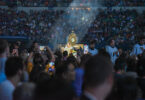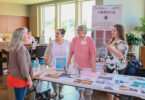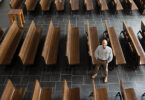Protégé of slain prelate advocates for the canonization of his archbishop
by Joe Bollig
joe.bollig@theleaven.org
El Salvador in 1980 was ruled by fear and stalked by paranoia.
Behind the mask of routine life in the Latin American country, a low-grade civil war was being waged.
On one side of this war were the Marxists who wanted to take over the country. On the other was the powerful oligarchy that had ruled the Central American country for more than a century.
Caught in between were the ordinary people: the poor, farmers, workers of all kinds, teachers, social reformers and those involved in church ministry and service.
“In less than three years, more than 50 priests have been attacked, threatened, calumniated,” said Archbishop Oscar Romero of San Salvador in a speech at the Catholic University of Louvain, Belgium, on Feb. 2, 1980.
“Six [priests] are already martyrs — they were murdered,” the archbishop continued. “Some have been tortured and others expelled. Nuns have also been persecuted.”
There had been bombings, kidnappings, disappearances, raids, threats, intimidation, beatings and murders.
Despite the danger, Fredis Sandoval refused his father’s request to leave the seminary and lay low for his own safety.
On March 24, 1980, he and the other seminarians at the National Interdiocesan Seminary were in the chapel, quietly praying after Communion.
But then Sandoval noticed something unusual. The seminary gatekeeper came into the chapel and said something to the dean.
“Immediately, it was announced — the assassination of Archbishop Romero,” said Father Sandoval, who visited the Archdiocese of Kansas City in Kansas in March.
The young seminarian was stunned. Archbishop Romero was not only a hero and hope to the people of El Salvador. He was also Sandoval’s friend and the man who brought him into the seminary. He had shared many meals and conversations with the archbishop.
“We were petrified,” said Father Sandoval. “We thought about the atrocity of this crime. We had already conducted five different funerals for five different priests. We knew of the threats to Archbishop Romero. He actually spoke against these threats in some of his homilies and radio interviews. Therefore, we knew there was a possibility.
“However, the assassination of Archbishop Romero took us by surprise.”
The students knew this, too: If the murderers were willing to kill someone like the archbishop, they wouldn’t think twice about murdering anyone else.
A man of the people
Father Sandoval came to the United States in March to visit Salvadoran communities and to reconnect with parishes that have long-established ties with El Salvador.
In addition to serving as a chaplain and professor at the Colegio Santa Teresa de Jesus in San Marcos, El Salvador (a high school), he is a founding member of Concertacion Romero (the “Romero Coalition”), which advocates for a full investigation and accounting of the assassination of the archbishop.
Among the places he visited was Bishop Ward High School in Kansas City, Kan., where he spoke about Archbishop Romero to students. He spoke through an interpreter, Senior Master Patrolman Santiago Vasquez with the Kansas City, Kansas Police Department and school resource officer for Bishop Ward.
His visit was all the more notable because it occurred on the 34th anniversary of Archbishop Romero’s assassination and at a time when Pope Francis has “unblocked” the archbishop’s cause for beatification.
Father Sandoval grew up in the Diocese of Santiago de Maria in El Salvador — the same diocese in which Archbishop Romero was born, although their hometowns were about 50 miles apart.
“The first time I spoke to him was when he came to my town,” said Father Sandoval. “He came to celebrate the Mass of the local patron saint on March 2, 1975.”
“I knew that the new bishop . . . had arrived,” he continued. “And I knew that as soon as I began my years of [seminary] studies, I would personally visit with him. On that particular day, I was going to show up at the seminary to start my new school year. Then I told him my name, and that I was a seminarian and on that day I was to present myself. And then he told me, ‘You need to come with me.’”
Over the next couple of years, Father Sandoval would have many meals with Archbishop Romero and they would discuss his vocation, among other things.
“It was his habit that, every time you visited him . . . he would offer you something [to eat],” Father Sandoval said. “He was so hospitable. . . . It was a very amicable, close and sincere relationship that he offered.”
“And this was [his way] to everyone,” he continued. “It was not uncommon to see [the archbishop] come into contact with people in the streets. He was on foot all the time, walking the streets.”
Long before Pope Francis urged this of clerics, Archbishop Romero was a shepherd “with the smell of the sheep.”
A prophetic voice
The appointment of Bishop Oscar Romero as archbishop of San Salvador on Feb. 23, 1977, was greeted with enthusiasm by the repressive government and with dismay by those who wanted justice for the oppressed and poor.
This was because Bishop Romero had a reputation for being theologically conservative and personally cautious.
But if both sides had observed him carefully before his appointment, they would have seen a man who was evolving in his thoughts about justice, peace and reconciliation. He was already finding his prophetic voice.
Archbishop Romero’s prophetic voice soon grew louder as he advocated for justice and denounced human rights abuses and the persecution of the church. His weekly sermons on the radio were like bread to a nation starved for information by official censorship and fear. It was the only place to find the truth.
His radio sermon the day before his murder may have been the final straw for the men who marked him for assassination. In effect, he was urging holy insubordination by members of the army and police.
“Brothers, you come from our own people,” said the archbishop. “You are killing your own brother peasants when any human order to kill must be subordinate to the law of God which says, ‘Thou shalt not kill.’ No soldier is obligated to obey an order contrary to the law of God. No one has to obey an immoral law. It is high time you recovered your consciences.”
A voice unsilenced
Archbishop Romero was killed while celebrating Mass for a family of a deceased priest in a chapel at La Divina Providencia (“The Divine Providence”) hospital, where he lived.
He was not elevating the chalice, as is sometimes reported, said Father Sandoval. He had finished the homily and walked to a place near the altar when a shot came from outside the chapel, through the open doors to the street.
There is a recording of his last words and the shot that killed him: “. . . prayers for Dona Sarita and for us . . . (shot, followed by outcry).”
The triggerman and the conspirators were never arrested, convicted or tried.
If the killers thought that death would silence Archbishop Romero, however, they were spectacularly wrong. He became an even greater symbol for the common people of El Salvador and the world in the struggle for dignity and justice — more powerful in death than he ever was in life.
Indeed, he had predicted just that. In an interview just days before his death, he told the reporter that “you can tell the people that if they succeed in killing me, that I forgive and bless those who do it. Hopefully, they will realize they are wasting their time. A bishop will die, but the church of God, which is the people, will never perish.”
“He is a symbol of freedom, justice and Gospel values for the church today,” said Father Michael Hermes, who as president of Bishop Ward had invited Father Sandoval to the school to speak. “He was someone who lived and died in our day. At this time, I think he could be more popular outside of El Salvador than inside. We have access to a lot of his writings in English and this has helped make him so well-known and popular around the world.”
Even now a saint?
Many people in El Salvador, at the time of his death and now, consider Archbishop Romero a saint. But the official canonization process didn’t begin until 1990, and he wasn’t given the title “servant of God” until 1997. The cause for beatification was blocked for a while, but was unblocked by Pope Francis last year.
The trickier question — but an important distinction to many — is whether he is also a martyr. At least one major player might have already weighed in on the matter.
During his first visit to El Salvador in 1983, Pope John Paul II prayed at Archbishop Romero’s tomb in the cathedral in San Salvador, despite opposition from the government and from within the church.
And during Jubilee Year celebrations in 2000, when he was commemorating 20th-century martyrs at Rome’s Coliseum, John Paul II insisted that Archbishop Romero be included — again, in opposition to some within the church.
Throughout Pope Benedict’s papacy, the discomfort of many about liberation theology still hung like a specter over the Salvadoran’s canonization prospects. But, perhaps no longer.
“I think Pope Francis is signaling that the church has moved beyond the debate over liberation theology and is no longer afraid that sainthood for Archbishop Romero would be subject to ideological exploitation,” said John Thavis, Vatican journalist and author of “The Vatican Diaries.” “This was the reason the sainthood cause was stalled under Pope Benedict, who believed Archbishop Romero was a martyr, but feared he would be co-opted as a political figure.”
“I think Pope Francis sees in Archbishop Romero precisely the kind of bishop needed by the church in the modern age: an advocate for the poor and oppressed, and a pastor who suffers with his flock,” Thavis continued.
“If he is declared a saint, it will, of course, have special meaning for El Salvador and Latin America. But I’m sure the pope will present him as a more universal figure: as a man who put his life on the line when he stood with victims of sin and injustice.”
Father Sandoval believes that the canonization of Archbishop Romero is inevitable. But he is a passionate advocate of not only his mentor being named a saint, but also a martyr.
Without understanding that sometimes following Christ requires the exercise of what Pope John Paul II called the “preferential option for the poor,” Archbishop Romero’s courting of the violent death he experienced would be misunderstood.
Archbishop Romero was forced to choose.
And he chose the poor.
“If we are coherent with the Gospel of the Lord, if we follow the doctrine of the church . . . [that informed] his life and mission, we have to recognize Archbishop Romero a martyr,” said Father Sandoval.
“If we only recognize him as a saint,” he added, “we will then abandon the prophesies of Archbishop Romero and the martyrdom of the church.”






